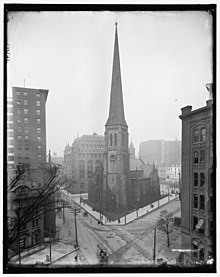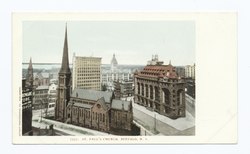St. Paul's Cathedral (Buffalo, New York): Difference between revisions
Buffalo128 (talk | contribs) |
|||
| Line 50: | Line 50: | ||
The building was listed on the [[National Register of Historic Places]] as '''St. Paul's Episcopal Cathedral''' in 1973. In 1987, the NRHP listing was revised as "St. Paul's Cathedral (Buffalo)" <ref>A new NRHP reference number was issued. The purpose of revision is not specifically known in this case, but NRHP listings are often revised to reflect boundary changes.</ref> and the property was further declared a U.S. [[National Historic Landmark]].<ref name="nhlsum"/><ref name="nrhpinv">{{citation|title=National Register of Historic Places Inventory-Nomination: St. Paul's Cathedral|url={{NHLS url|id=73002298}} |format=pdf|author=Carolyn Pitts|date=n.d.|publisher=National Park Service}} and {{NHLS url|id=73002298|title=''Accompanying 2 photos, from 1965''|photos=y}} {{small|(368 KB)}}</ref> |
The building was listed on the [[National Register of Historic Places]] as '''St. Paul's Episcopal Cathedral''' in 1973. In 1987, the NRHP listing was revised as "St. Paul's Cathedral (Buffalo)" <ref>A new NRHP reference number was issued. The purpose of revision is not specifically known in this case, but NRHP listings are often revised to reflect boundary changes.</ref> and the property was further declared a U.S. [[National Historic Landmark]].<ref name="nhlsum"/><ref name="nrhpinv">{{citation|title=National Register of Historic Places Inventory-Nomination: St. Paul's Cathedral|url={{NHLS url|id=73002298}} |format=pdf|author=Carolyn Pitts|date=n.d.|publisher=National Park Service}} and {{NHLS url|id=73002298|title=''Accompanying 2 photos, from 1965''|photos=y}} {{small|(368 KB)}}</ref> |
||
St. Paul’s Episcopal Cathedral, located at the very heart of the greater Buffalo metropolitan community, just celebrated its two-hundredth anniversary of its founding on February 12, 2017. |
|||
The theme of the Bicentennial event was: “Celebrating the past. Embracing the future.” |
|||
During the two centuries of St. Paul’s history, four distinct stages of development can be identified. The incorporation of St. Paul’s Church in Buffalo on February 10, 1817, barely three years after the burning of the village by the British during the War of 1812, began the Church’s first phase. In 1819, a building site was donated to the young congregation by the Holland Land Company, and Buffalo’s first permanent house of worship was soon erected. The building was consecrated by the Rt. Rev. John Henry Hobart, Episcopal Bishop of the Diocese of New York, on February 25, 1821. It was a wooden structure and remained at this site until 1849 when it was sold and moved to another location. |
|||
A major milestone and one denoting the Church’s second period of growth was the consecration in 1851 of the new, sandstone edifice, designed by Richard Upjohn, also the architect of such notable churches as Trinity Church, New York City. The year 1866 marked St. Paul’s designation by Bishop Arthur C. Coxe as the Cathedral Church of the Diocese of Western New York. Tragically, on May 22, 1888, the interior of the Cathedral was destroyed by an explosion and fire. The Vestry, on that very day, voted to rebuild St. Paul’s anew from the ashes and rubble left by the conflagration. |
|||
The restored St. Paul’s Cathedral of 1890 inaugurated the third period of its development, bridging the transition from Victorian nineteenth century to the rapid technical advancements and social changes of the twentieth century. It was during this period that our Church determined, despite surrounding urban changes, to remain a downtown community. The ten decades since the centennial year of 1917 have witnessed wars, booms, a depression, the decline, and the recent resurgence of downtown Buffalo; all of which have presented new challenges and opportunities to the membership of the Cathedral. In 1988, National Landmark Status was awarded to St. Paul’s Cathedral. |
|||
The fourth stage of church growth began recently with the opening of the Flickinger Ministry Center at 4 Cathedral Park in the fall of 2014, and with the placing of both the “Homeless Jesus” sculpture and the Garden of Love (an outdoor donation site for winter clothing) near Main Street in 2015. Through such accomplishments, the people of St. Paul’s Cathedral have proven their commitment to the continuation of its long history of social service, ecumenicalism and spiritual ministry in the metropolitan area. |
|||
== Gallery == |
== Gallery == |
||
Revision as of 19:25, 8 June 2017
| Saint Paul's Cathedral | |
|---|---|
 | |
 | |
| Location | 139 Pearl Street, Buffalo, New York |
| Country | |
| Denomination | Episcopal |
| Website | St. Paul's Episcopal Cathedral |
| History | |
| Status | Parish church |
| Founded | 10 February 1817 |
| Founder(s) | Samuel Johnston |
| Dedicated | 22 October 1851 |
| Consecrated | 22 October 1851 |
| Architecture | |
| Functional status | "Active" |
| Completed | May 1873 |
| Construction cost | US$160 thousand |
| Specifications | |
| Height | 274 feet (83.5 m) |
| Materials | Medina sandstone |
St. Paul's Cathedral (Buffalo) | |
 St. Paul's Cathedral, ca. 1900 | |
| Location | Buffalo, NY |
| Coordinates | 42°52′57.6″N 78°52′34.95″W / 42.882667°N 78.8763750°W |
| Built | 1849–1851 |
| Architect | Richard Upjohn; Robert W. Gibson |
| Architectural style | Gothic Revival |
| NRHP reference No. | 73002298 87002600 (increase)[1] |
| Significant dates | |
| Added to NRHP | March 1, 1973[1] December 23, 1987 (increase)[1] |
| Designated NHL | December 23, 1987 [2] |
St. Paul's Cathedral is the cathedral of the Episcopal Diocese of Western New York and a landmark of downtown Buffalo, New York. The church sits on a triangular lot bounded by Church St., Pearl St., Erie St., and Main St.
History
In 1848, vestrymen of St. Paul's in Buffalo formed a building committee to erect a new stone church. Being familiar with architect Richard Upjohn’s work through his recently completed Trinity Church in New York City, they desired no other architect for the job, and immediately engaged Upjohn for the commission.[3]
Major structural events:;[4][5][6][7]
- 1849: construction started.
- 1851: the cathedral was dedicated/consecrated.
- 1870: the spires on top of the two towers were finished.
- 1888: a fire caused by a natural gas explosion nearly destroyed the building.
- 1890: the church reopened after undergoing a renovation overseen by Robert W. Gibson.
The building was listed on the National Register of Historic Places as St. Paul's Episcopal Cathedral in 1973. In 1987, the NRHP listing was revised as "St. Paul's Cathedral (Buffalo)" [8] and the property was further declared a U.S. National Historic Landmark.[2][9]
St. Paul’s Episcopal Cathedral, located at the very heart of the greater Buffalo metropolitan community, just celebrated its two-hundredth anniversary of its founding on February 12, 2017.
The theme of the Bicentennial event was: “Celebrating the past. Embracing the future.”
During the two centuries of St. Paul’s history, four distinct stages of development can be identified. The incorporation of St. Paul’s Church in Buffalo on February 10, 1817, barely three years after the burning of the village by the British during the War of 1812, began the Church’s first phase. In 1819, a building site was donated to the young congregation by the Holland Land Company, and Buffalo’s first permanent house of worship was soon erected. The building was consecrated by the Rt. Rev. John Henry Hobart, Episcopal Bishop of the Diocese of New York, on February 25, 1821. It was a wooden structure and remained at this site until 1849 when it was sold and moved to another location.
A major milestone and one denoting the Church’s second period of growth was the consecration in 1851 of the new, sandstone edifice, designed by Richard Upjohn, also the architect of such notable churches as Trinity Church, New York City. The year 1866 marked St. Paul’s designation by Bishop Arthur C. Coxe as the Cathedral Church of the Diocese of Western New York. Tragically, on May 22, 1888, the interior of the Cathedral was destroyed by an explosion and fire. The Vestry, on that very day, voted to rebuild St. Paul’s anew from the ashes and rubble left by the conflagration.
The restored St. Paul’s Cathedral of 1890 inaugurated the third period of its development, bridging the transition from Victorian nineteenth century to the rapid technical advancements and social changes of the twentieth century. It was during this period that our Church determined, despite surrounding urban changes, to remain a downtown community. The ten decades since the centennial year of 1917 have witnessed wars, booms, a depression, the decline, and the recent resurgence of downtown Buffalo; all of which have presented new challenges and opportunities to the membership of the Cathedral. In 1988, National Landmark Status was awarded to St. Paul’s Cathedral.
The fourth stage of church growth began recently with the opening of the Flickinger Ministry Center at 4 Cathedral Park in the fall of 2014, and with the placing of both the “Homeless Jesus” sculpture and the Garden of Love (an outdoor donation site for winter clothing) near Main Street in 2015. Through such accomplishments, the people of St. Paul’s Cathedral have proven their commitment to the continuation of its long history of social service, ecumenicalism and spiritual ministry in the metropolitan area.
Gallery
-
Exterior of church, 1965
-
Interior of church, 1965
-
Exterior of church, 2009
References
- ^ a b c "National Register Information System". National Register of Historic Places. National Park Service. January 23, 2007.
- ^ a b "St. Paul's Cathedral (Buffalo)". National Historic Landmark summary listing. National Park Service. Retrieved 2007-09-19.
- ^ Napora, James. "Saint Paul's Episcopal Church: 1849–1851". Retrieved 2014-09-04.
- ^ "Cultural Resource Information System (CRIS)" (Searchable database). New York State Office of Parks, Recreation and Historic Preservation. Retrieved 2016-04-01. Note: This includes Cornelia E. Brooke (May 1972). "National Register of Historic Places Registration Form: St. Paul's Cathedral" (PDF). Retrieved 2016-04-01. and Accompanying four photographs
- ^ Carolyn Pitts (c. 1987). "National Register of Historic Places increase / National Historic Landmark Registration: St. Paul's Cathedral". New York State Office of Parks, Recreation and Historic Preservation. Retrieved 2009-06-14.
- ^ "Accompanying four photos".
- ^ LaChiusa, Chuck. "St. Paul's Episcopal Cathedral". Retrieved 2011-05-25.
- ^ A new NRHP reference number was issued. The purpose of revision is not specifically known in this case, but NRHP listings are often revised to reflect boundary changes.
- ^ Carolyn Pitts (n.d.), National Register of Historic Places Inventory-Nomination: St. Paul's Cathedral (pdf), National Park Service and Accompanying 2 photos, from 1965 (368 KB)
External links
- Official website
- Historic American Buildings Survey (HABS) No. NY-5612, "St. Paul's Episcopal Cathedral, Shelton Square, Buffalo, Erie County, NY", 12 photos, 9 data pages
- Skyscraper page building entry
- Emporis building entry
- Historic American Buildings Survey in New York
- National Historic Landmarks in New York
- Churches on the National Register of Historic Places in New York
- Churches completed in 1850
- 19th-century Episcopal churches
- Churches in Buffalo, New York
- Gothic Revival churches in New York
- Tourist attractions in Buffalo, New York
- Episcopal cathedrals in New York
- Buildings and structures in Buffalo, New York
- National Register of Historic Places in Buffalo, New York







